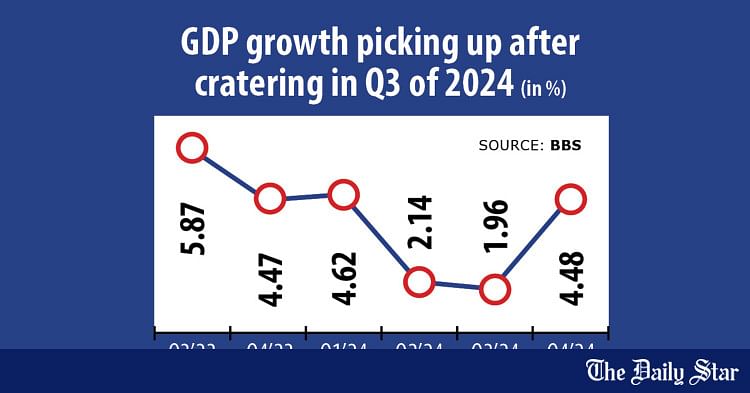Bangladesh’s economy started showing signs of a turnaround in the second quarter of the fiscal year, official statistics show, although economists caution that Trump’s tariff measures are likely to slow down the momentum.
Between October and December last year, Bangladesh’s GDP expanded by about 4.5 percent to Tk 886,800 crore, according to the Bangladesh Bureau of Statistics, the state agency for collecting data on demographics, the economy and other facts.
In the previous quarter, the GDP growth was about 2 percent. The second quarter’s recovery was led by manufacturing growth: the industrial GDP grew 7.1 percent in contrast to 2.4 percent the previous quarter.
Agricultural growth was about 1.3 percent in contrast to 0.8 percent the preceding three months, while service sector growth was 3.8 percent, up 137 basis points from the previous quarter.
The second quarter GDP growth was more in line with the International Monetary Fund’s latest projection of about 4 percent growth for this fiscal year, up from about 3.8 percent previously.
“This is a recovery — there is no ambiguity about this,” said Zahid Hussain, a former lead economist of the World Bank’s Dhaka office.
The first quarter of fiscal 2024-25 was affected by two calamities: the July uprising and then the floods in August.
“The twin events had affected the farming, manufacturing and services sectors. But from October onwards, there were fewer economic disruptions and hence both agricultural and manufacturing production picked up pace.”
Besides, both exports and remittances were strong during the quarter, he said.
Exports raked in about $12.9 billion during the quarter, up about 18 percent year-on-year, according to data from the Export Promotion Bureau.
Remittance inflows soared 22.8 percent year-on-year to $7.2 billion during the quarter, according to Bangladesh Bank data.
Manufacturing growth is directly connected to exports, while remittance has a direct impact on domestic demand.
“If both agriculture and manufacturing do well, the service sector will automatically improve. And that is what transpired. The economy did not normalise — it was not out of the woods — but it was better than the first quarter,” he added.
There was definitely a turnaround in the second quarter of the fiscal year, said Mustafizur Rahman, distinguished fellow at the Centre for Policy Dialogue.
The third quarter data is poised to be better than the previous two quarters, said Hussain, who was part of the 12-member committee that recently prepared a white paper on the state of the Bangladesh economy.
“Normalcy began to return, while both export and remittance receipts remained buoyant. The balance of payment situation improved, while there was stability in the macroeconomic front, the foreign exchange market and even the financial sector. The panic is no longer there.”
However, the US administration’s announcement of a fresh 37 percent tariff on Bangladeshi products to the market, the single largest export destination for the country’s goods, threatens to derail the momentum.
“Trump tariff is a big risk factor. In any case, exports will be affected — there is a new risk to manufacturing growth.”
The measures taken by the interim government so far on the tariff measures are unlikely to enforce a reversal of a decision by US President Donald Trump.
“I don’t think the two letters [by Bangladesh] would make Trump change his decision — a lot needs to be done now.”
There is also the risk of a global recession as a result of the tariff war brought on by Trump.
“In that case, the impact on exports will be even more,” Hussain added.
However, Rahman begs to differ.
“There will be some negative impact on imports. But in the context of GDP, there won’t be much impact as exports’ share in GDP has declined over the years.”
Manufacturing GDP will be impacted as it is mainly export-oriented.
“But the strong trend of remittance inflow will have a positive impact on consumer demand and can pick up the slack left behind by exports. I don’t envisage there will be any big impact on the overall GDP growth.”


